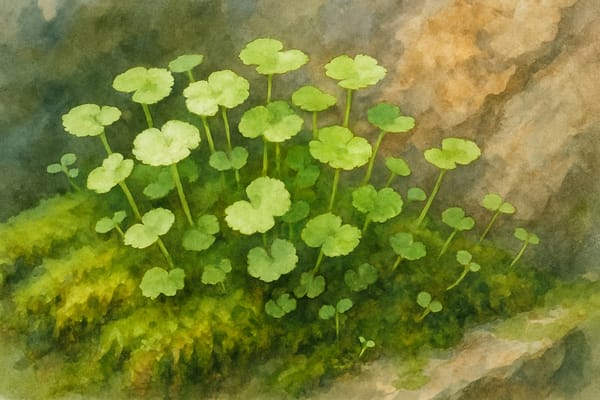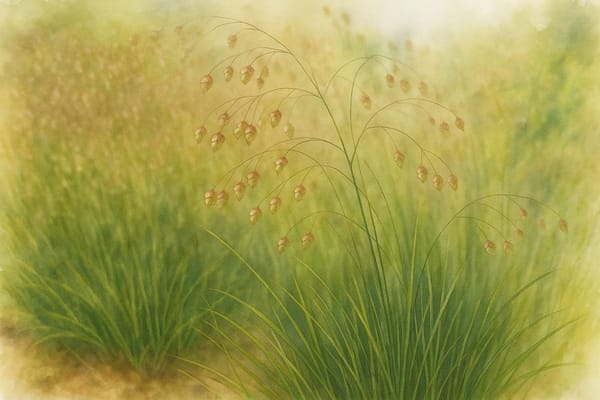A Quiet Emblem of Cornwall's Shady Wetlands
Historical and Cultural Significance
Cornish Moneywort (Sibthorpia europaea) is a low-growing, mat-forming perennial that has long been part of Cornwall’s quiet botanical identity.
- Regional Rarity: Native to Cornwall, Devon, and parts of Wales, this plant thrives in the mild, humid microclimates of the southwest. Its limited UK distribution has made it a symbol of the region’s ecological uniqueness.
- Botanical Legacy: First recorded in Cornwall by John Ray in 1662, it was valued by early naturalists and featured in prize lists and herbaria as a locally rare species. The small, round, coin-like leaves contributed to its charm and folkloric appeal.
- Folklore and Symbolism: Known colloquially as "penny-pies," the leaves were believed to represent luck and prosperity. Though not a central figure in Cornish folklore, it appeared in stories of hidden places and quiet abundance.
- Medicinal Use: Traditionally used across Europe in herbal medicine for minor ailments, Cornish Moneywort was once associated with wound-healing and internal remedies—though its use has largely faded.
- Conservation Significance: Now recognised as a conservation priority, it serves as an indicator species for Cornwall’s fragile wetland ecosystems, particularly where traditional land management has persisted.
Growing and Caring for Cornish Moneywort in Coastal Gardens
Cornish Moneywort is ideal for gardeners aiming to create a damp, shady groundcover that nods to native ecology. It performs best in mild, sheltered coastal gardens that mimic its woodland or streamside origins.
Ideal Growing Conditions
| Factor | Recommendation |
|---|
| Light | Partial shade to bright, indirect light |
| Soil | Moist, well-drained, acidic to neutral, rich in organic matter |
| Humidity | High; benefits from regular misting or naturally humid air |
| Exposure | Sheltered from strong winds and salt spray |
| Watering | Keep consistently moist; do not allow to dry out |
| Temperature | Mild, frost-free if possible, or with winter protection |
Care Tips for Success
- Positioning: Choose a site near ponds, under trees, or beside shaded walls. Avoid dry, sunny exposures.
- Soil Prep: Enrich with compost or leaf mould to retain moisture and encourage root spread.
- Watering: Ensure regular watering during dry spells, particularly in coastal areas where wind can desiccate leaves.
- Shelter: Use hedges or garden structures to protect from wind. Avoid exposure to salty air.
- Companion Plants: Combine with ferns, primroses, violets, or other shade lovers to create a soft, layered woodland effect.
- Propagation: Spreads easily by division or rooted stems. Allow it to form carpets naturally over time.
Ecological Benefits
- Wildlife Support: Offers microhabitats for invertebrates and helps retain soil moisture along water edges.
- Habitat Restoration: Can be used in gardens designed to mimic Cornwall’s wet woodland or heath-edge ecosystems.
- Low Maintenance: Once established, requires minimal care beyond ensuring consistent moisture and protection from harsh conditions.
Quick Reference Summary: Cornish Moneywort at a Glance
| Aspect | Details |
| Cultural Significance | Regional rarity; historic records; folklore links to luck |
| Soil | Moist, humus-rich, acidic to neutral |
| Sunlight | Partial shade or filtered light |
| Exposure | Sheltered from wind and salt |
| Wildlife Value | Groundcover for invertebrates; erosion control |
| Garden Use | Woodland edges, pond margins, shady banks |
| Maintenance | Low if moisture and shade are maintained |
Final Note
Delicate but persistent, Cornish Moneywort is a native gem that quietly weaves through Cornwall’s ecological and cultural story. By growing it thoughtfully, gardeners not only honour its botanical past but help protect its fragile future.











